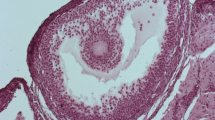Summary
-
1.
There is an apparent discrepancy between the facts pointing to the male as the sex heterozygous parent in mammals, and the facts which show that the mother has some influence on the sex-ratio at birth. Chief among the latter are those relating to the influence on the sex-ratio of the age of the mother and the number of the pregnancy.
-
2.
The only sex-ratio, however, which we know to be affected by the mother is the ratio at birth, whereas the facts of sex determination are, concerned solely with the ratio at the time of conception, or when sex is first determined.
-
3.
It is possible, therefore, that changes in the sex-ratio between conception and birth may account for the apparent anomaly, and this would reconcile the two opposing sets of facts.
-
4.
As changes in the sex-ratio after sex determination can only go on as a result of unequal elimination of the sexes the source of any change in the sex-ratio during gestation must be sought in a sexually differential pre-natal mortality.
-
5.
Other authors have made it clear that there is a considerable amount of pre-natal mortality which falls more heavily on the males than on the females, and the material here presented shows that pre-natal mortality occurs preponderatingly with older mothers and in later pregnancies.
-
6.
These facts substantiate the possibility that the decrease in the sex-ratio with older mothers and at higher parities is brought about as the result of increased pre-natal wastage of males, and not as the result of an increased proportion of females at sex determination.
-
7.
Influences exerted by the mother, therefore, have no relation to sex determination, and offer no contradiction to the chromosome theory of sex determination, which implies that the male controls determination.
Similar content being viewed by others
Bibliography
Ahlfeld (1876). “Ueber den Knabenüberschuss älterer Erstegebärenden.”Arch. f. Gyn. Vol. ix.
Allen (1918). “Studies in cell division in the Albino Rat. iii. Spermatogenesis: the origin of the first spermatocytes and the organisation of the chromosomes, including the accessory.”Journ. Morph. Vol. xxxi.
Auerbach (1912). “Das wahre Geschlechts-verhältnis der Menschen.”Archiv f. Rassen- u.Gesellchafts-Biol. Vol. ix.
Carvallo (1912), “La Masculinité dans les naissances humaines.”Compte rendu Ass. franç, pour l’avancement des Sciences, Vol, xli.
Copeman andParsons (1904). “Observations on the Sex of Mice.”Proc. Roy. Soc. Vol Lxxiii.
Düsing (1884). “Die Regulierung des Geschlechta-verhältnisses bei der Vermehrung, etc.”Jenaische Zeitsch. Vol. xvii.
Felkin (1886). “Notes on the Waganda Tribe of Central Africa.”Proc. R. Soc. Edin. Vol. xiii.
Goldsohmidt (1920).Mechanismus und Physiologie der Geschlechtsbestimmung. Berlin.
Guyer (1910). “Accessory Chromosomes in Man.”Biol. Bull. Vol. xix.
- (1914). “Accessory Chromosomes in Man.”Sci. Vol. xxxix.
King (1918). “Studies on Inbreeding. iii. The Effects of Inbreeding with Selection on the Sex-Ratio of the Albino Eat.”Journ. Exp. Zool. Vol. xxvii.
Körösy (1898).Die Sterblichkeit der Hauptstadt Budapest Berlin.
Lenhossek (1903).Das Problem der geschlechtsbestimmenden Ursachen. Jena.
Little (1920). “Note on the Human Sex-Ratio.“Proc. Nat. Acad. Sci. U.S. Vol. vi.
Malone (1918). “Spermatogeneais in the Dog.”Trans. Am. Micr. Soc. Vol. xxxvii.
Newcomb (1904). “A Statistical Inquiry into the Probability of Causes of the production of Sex in Human Offspring.”Carnegie Institution Publications, Washington.
Pantter (1923).Journ. Exp. Zool. Vol. xxxviii.
Parkes (1921). “Sex Heredity.”Sci Pro. Vol. xv.
Punhett (1904). “On Nutrition and Sex Determination in Mein.“Proc. Gambs. Phil. Soc. Vol. xii.
Rauber (1900).Der Ueberschuss an Knabengeburten und Scine biologische Bedeutung. Leipzig.
Rosenfeld (1900). “ Die Sexualproportion in Oesterreich in den Jahren 1895–6.”Wien. Med. Bl. Vol. xxiii.
Routh (1914). “Ante-natal hygiene.”Brit. Med. Journ. Feb. 14th.
Schultz (1918). “Studies in the Sex-ratio in Man.”Biol. Bull. Vol. xxxiv.
Wentworth (1916). “A sex-limited character in Ayrshire cattle.”Journ. Agr. Research, Vol. vi.
Williams (1912).Obstetrics. New York.
Von Winiwarter (1909).Arch. Biol. Vol. xxiv.
-(1912). “Études sur la spermatogénèse humaine. ii. Hétérochromosomes et mitoses de Pépithélium séminal.”Arch. de Biol. Vol. xxvii.
Wodsedalek (1913). “Spermatogenesis in the Pig.”Biol. Bull. Vol. xxv.
-(1920). “Studies on the cells of cattle with special reference to Spermatogenesis, cogonia, and sex-determination,”Biol. Bull. Vol. xxxviii.
Yocum (1917). “Some phases of Spermatogenesis in the Mouse.”Berkeley Univ. Cal. Pub. Zool. Vol. xvi.
Author information
Authors and Affiliations
Rights and permissions
About this article
Cite this article
Parkes, A.S. Studies on the sex-ratio and related phenomena. Journ. of Gen. 14, 39–47 (1924). https://doi.org/10.1007/BF02983083
Issue Date:
DOI: https://doi.org/10.1007/BF02983083




